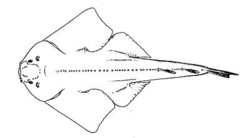Angel sharks
2008/9 Schools Wikipedia Selection. Related subjects: Insects, Reptiles and Fish
| Angel sharks Fossil range: Late Oxfordian to Present |
||||||||||||||
|---|---|---|---|---|---|---|---|---|---|---|---|---|---|---|
 Sand devil, Squatina dumeril
|
||||||||||||||
| Conservation status | ||||||||||||||
| Scientific classification | ||||||||||||||
|
||||||||||||||
| Species | ||||||||||||||
|
See text. |
The angel sharks are an unusual genus of sharks with flattened bodies and broad pectoral fins that give them a strong resemblance to skates and rays. The 16-odd known species are in the genus Squatina, the only genus in its family, Squatinidae, and order Squatiniformes. They occur worldwide in temperate and tropical seas.
Appearance
While the forward part of the angel shark's body is broad and flattened, the rear part retains a muscular appearance more typical of other sharks. The eyes and spiracles are on top, and the five gill slits are on bottom. Both the pectorals and the pelvic fins are large and held horizontally. There are two dorsal fins, no anal fin, and unusually for sharks, the lower lobe of the caudal fin is longer than the upper lobe. Most types grow to a length of 1.5 m (5 ft), with the Japanese angel shark, Squatina japonica, known to reach 2 m.
Habitat
Angel sharks bury themselves in sand or mud, and then jump up to snap up prey, which includes fish, crustaceans, and various types of mollusks.
Behaviour
Although they are not normally aggressive, they do bite when stepped on or handled. If they are left alone they will not attack.
Reproduction
Angel sharks are ovoviviparous, with litters known up to 13 pups.
Commercial value
The sharks were long considered of no commercial interest, but in 1978, Michael Wagner, a fish processor in Santa Barbara, California, began to promote angel sharks, and 310 metric tons were taken off California in 1984. The fishery devastated the population and is now regulated.
Protection
Angel sharks have historically been heavily fished but education has played a role in reducing over fishing of these slow-reproducing chondrichthyes. In April 2008 the UK Government afforded the angel shark full protection under the Wildlife and Countryside Act.
Species
- Sawback angelshark, Squatina aculeata Cuvier, 1829
- African angelshark, Squatina africana Regan, 1908
- Argentine angelshark, Squatina argentina (Marini, 1930)
- Chilean angelshark, Squatina armata (Philippi, 1887)
- Australian angelshark, Squatina australis Regan, 1906
- Pacific angelshark, Squatina californica Ayres, 1859
- Sand devil, Squatina dumeril Lesueur, 1818
- Taiwan angelshark, Squatina formosa Shen & Ting, 1972
- Angular angel shark, Squatina guggenheim Marini, 1936
- Japanese angelshark, Squatina japonica Bleeker, 1858
- Clouded angelshark, Squatina nebulosa Regan, 1906
- Smoothback angelshark, Squatina oculata Bonaparte, 1840
- Squatina punctata Marini, 1936
- Squatina squatina (Linnaeus, 1758)
- Ornate angelshark, Squatina tergocellata McCulloch, 1914
- Ocellated angelshark, Squatina tergocellatoides Chen, 1963
- Eastern Australian angelshark, Squatina sp. A (provisional scientic name)
- Western Australian angelshark, Squatina sp. B (provisional scientic name)
- Cortez angelshark, Squatina sp. (provisional scientic name)